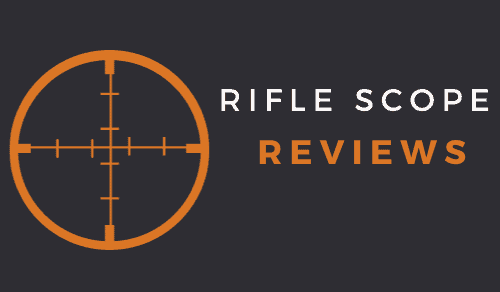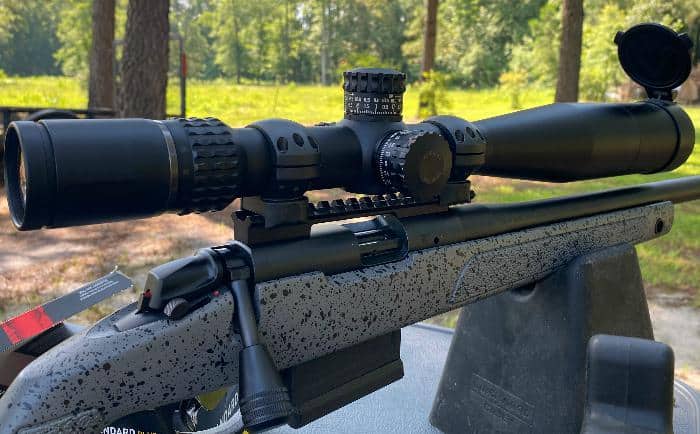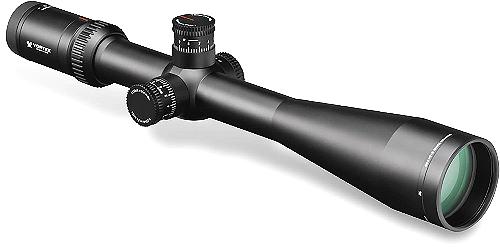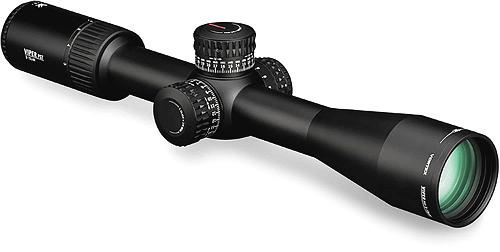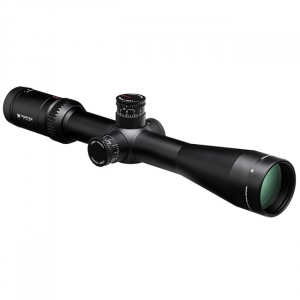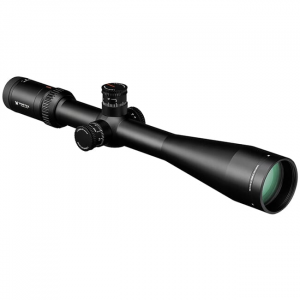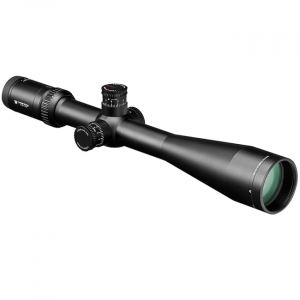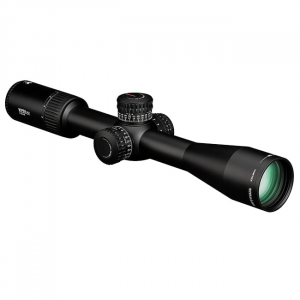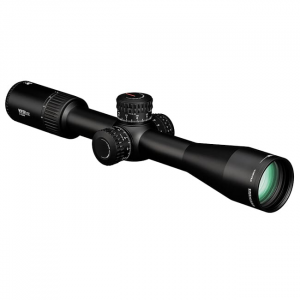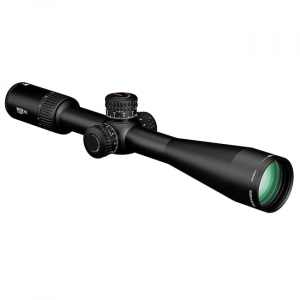As an Amazon Associate I earn from qualifying purchases. Amazon and the Amazon logo are trademarks of Amazon.com, Inc, or its affiliates.
Although Vortex Optics has only been in business a short time compared to brands like Leupold and Redfield, they have very quickly established themselves as a major player in the sporting optics market across nearly all the popular price points.
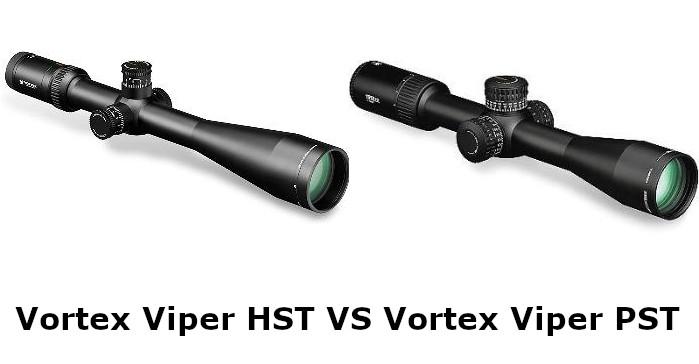 Vortex is a big seller at my day job, and I typically spend a significant amount of time answering questions about or demoing the various Vortex scope models. In many cases, I’m asked to compare one scope model in the Vortex line up against another in terms of performance, optical quality, reticles, etc.
Vortex is a big seller at my day job, and I typically spend a significant amount of time answering questions about or demoing the various Vortex scope models. In many cases, I’m asked to compare one scope model in the Vortex line up against another in terms of performance, optical quality, reticles, etc.
One comparison that I’m repeatedly asked about involves comparing the following series: The Vortex HST vs PST lines of scopes.
Before I get into a more detailed comparison, here’s a general overview of each of the scope series:
Vortex Viper HST scopes
The Vortex HST may be Vortex’s top-end second focal plane series of rifle scopes. This series is built for versatility as the “HST” acronym stands for Hunting Shooting Tactical. That same versatility means this series is marketed towards hunters, general shooters, and long-range shooters.
Currently, the HST scope series consists of two models, a 6 24X50 and a 4-16X44. Both models are built on a 30mm tube, and, as I mentioned before, both are only available in a second focal plane configuration.
Both models also feature side focus that will focus all the way down to 50 yards. The current reticle options for the HST scope series are the VMR-1 (MOA) and VMR-1 (MRAD). Both scope models also feature exposed tactical style turrets and are equipped with Vortex’s patented CRS Zero Stop.
Vortex Viper PST Gen II scopes
From a hierarchy standpoint, the Vortex PST Gen II scope series is a level above the HST series. Now that doesn’t necessarily mean that the PST series is “better”, as each buyer has their own set of criteria about which scope features are more important than others.
Where the HST series are only available in a second focal plane configuration, the PST Gen II series are available in both second focal plane configurations and first focal plane configurations (commonly shortened to FFP). The FFP configuration means that the PST Gen II scope models are more geared towards long-range shooting and tactical applications.
Where the HST series is only available in 2 models, the PST Gen II series is currently available in 6 configurations that range in magnification from 1-6X24 (which is really geared towards an AR platform) all the way to a 5-25X50 model (models actually as the 5-25X50 is available in both an FFP and SFP version).
The PST Gen II models are also built on a 30mm tube and are also equipped with side focus that goes all the way down to 20-25 yards (on most models). The PST Gen II series also features a zero stop system, but it’s different from the system found on the HST scope series. The PST uses Vortex’s patented RZR Zero Stop system, which is a very robust system in my opinion.
Reticle options for the PST Gen II scope models are dependent on their focal plane configuration. The first focal plane models originally available with 4 potential reticle options:
- EBR-2C (MOA)
- EBR-2C (MRAD)
- EBR-7C (MOA)
- EBR-7C (MRAD)
The PST Gen II models in SFP are only available in the EBR-4 reticle option.
It’s also worth noting that all the reticle options on the PST scopes are illuminated as well.
Here’s a quick side by side comparison of the basics between each of the respective scope lines:
| HST Scope | PST Gen II Scopes | |
| Tube Size | 30mm tube only | 30mm tube only |
| Power Ranges/Magnification Ranges | From 4-16 up to 6-24 | From 1-6x all the way up to 5-25x |
| Focal Plane | Second Focal Plane Only | First and Second Focal Plane |
| Reticle Options | VMR-1 (MOA) VMR-1 (MRAD). |
EBR-7C (MOA) (Illuminated) EBR-7C (MRAD) (Illuminated) EBR-4 (MOA) (Illuminated) |
| Zero Reset Functionality | Yes – CRS Zero Stop | Yes – RZR Zero Stop |
| Where are They Manufactured | Made in the Philippines | Made in the Philippines |
| Warranty | Vortex’s Lifetime Warranty | Vortex’s Lifetime Warranty |
| Turrets | Exposed Tactical MOA/MRAD Adjustments | Exposed Tactical MOA/MRAD Adjustments |
| Eye Relief | 4” | 3.2 – 3.4” |
| Objective Lens Diameter | 44mm 50mm |
24mm 32mm 44mm 50mm |
Now, let’s get into greater detail of comparing the main aspects and features of each of these Vortex scope series:
Tube Diameter
Both of these scope series are built on a 30mm tube, which, like most everything in life, has some pluses and minuses. On the plus side, the 30mm tube offers a much wider range of windage and elevation adjustments compared to a smaller 1-inch tube.
Glass Quality
Having spent some time both looking through and shooting under comparable (as in similar magnification power range) HST and PST Gen II scopes, I can say with certainty that the glass quality on the PST Gen II models is better than the glass on the HST. And that really shouldn’t come as a major surprise as the PST Gen II cost more than the HST series.
Now, to be clear, I’m in no way saying that the glass on the HST is bad. I’m of the opinion that it’s very good glass for the money, but the PST optical quality is better.
Reticle Options
The reticle options between the HST and PST Gen II scope series are different in a number of ways.
With the HST scope models, you have a choice of the VMR-1 reticle in either an MOA or MRAD version, which can be seen below:
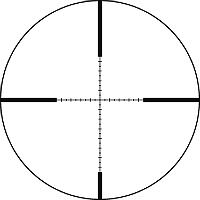 |
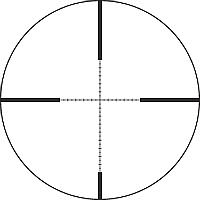 |
| Vortex VMR-1 MOA Reticle | Vortex VMR-1 MRAD Reticle |
As you can tell from the pics, they are exactly the same reticle, with the only difference being the MOA or MRAD configuration.
With the PST Gen II models, the FFP scope models are available with the EBR-7C in MOA or MRAD, and the SFP models are available with the EBR-4 MOA reticle. The EBR-7C is more of what’s called a “Christmas tree” type reticle that features floating wind hold dots for ranging, holdover, and windage corrections.
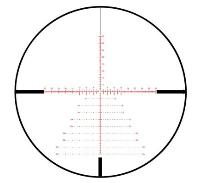 |
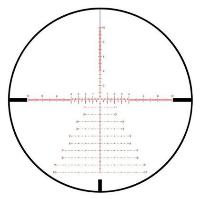 |
| Vortex EBR-7C MOA Reticle | Vortex EBR-2C MRAD Reticle |
I had previously mentioned that the PST Gen II models were once available with a reticle called the EBR-2C in an MOA or MRAD version. While Vortex has basically phased this reticle option out, you can still find some PST scopes available with this reticle configuration, so here’s what it looks like:
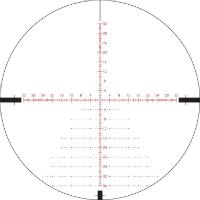 |
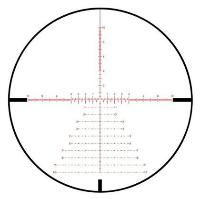 |
| Vortex EBR-2C MOA Reticle | Vortex EBR-2C MRAD Reticle |
The EBR-4 reticle is a ranging reticle, in either MOA or MRAD, that uses “subtension” lines for holdover and windage corrections, and it looks like this:
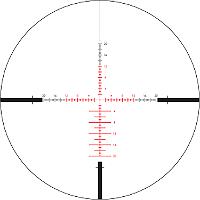 |
| Vortex Viper PST EBR-4 MOA Reticle |
So, in layman’s terms, what are the differences between the reticle options for the HST and the PST?
For starters, only the PST Gen II scopes have an illuminated reticle option. If you had narrowed your choices of scopes down to one of these two series, and you wanted an illuminated reticle, then the PST Gen II series would be your only option.
While the VMR-1 reticle options on the HST scope could certainly be used for long range shooting or precision shooting; the reticle options on the PST Gen II scopes are definitely more geared towards long distance shooting.
If you are looking at either of these two scope series and are more focused on hunting versus dedicated long range shooting, then I’d say the VMR-1 reticle is a better choice.
Focal Plane
While the first focal plane scope configuration has only been gaining mainstream popularity about the last 5 years or so, it has really gained a major following in the long distance shooting community. Prior to the last 5-7 years, everyone pretty much shot second focal plane and did the math for long distance.
Where the first focal plane scope configuration shines is long distance shooting as the reticle remains at scale so a 4MOA adjustment at 5 power is the same at 20 power. That’s a convenience that you just can’t get with a second focal plane scope.
However, the downside of a first focal plane reticle is the fact that the reticle itself starts out very small on the lower powers, and then gets larger as the power magnification is increased. The reticle being that small at the lower power takes some getting used to and may not be ideal for everyone.
If you are shopping for either of these scope series and want a first focal plane set-up, then one of the FFP PST Gen II models is really your only option as the HST series are SFP only.
If you aren’t in love with FFP, then you could consider either of the HST models or any of the PST Gen II models in an SFP scope configuration.
Eye Relief
The HST series of scopes is advertised as having an eye relief of 4”. My experience has been that it’s probably a little less than that, but still generous enough to work for most any caliber, including the high recoiling ones.
The PST Gen II series of scopes is advertised as having an eye relief anywhere from 3.2” to 3.4”. Based on my own experiences with the PST scope models, I’d say that’s probably fairly accurate. The 3.2” to 3.4” range in eye relief is still enough eye relief for most any caliber as well.
I will say that the 4” eye relief on the HST seemed to be a bit more critical in terms of head position compared to the PST series, but only by just a little bit.
Zero Stop
While both the HST and PST models feature a zero stop feature, they are different zero stop variants within the Vortex line of scopes.
The HST comes equipped with Vortex’s CRS Zero Stop system, with the CRS being an acronym for Custom Rotation Stop. This set-up is not a true mechanical stop system, but rather a system that utilizes shims. As it’s not a mechanical stop set-up when installed, the elevation turret can be dialed back down past the original zero point, but only a little bit, then the shooter has to turn the turret back to the original zero point manually.
The PST Gen II models are equipped with a different zero stop set-up called the RZR Zero Stop. This set-up is a true mechanical zero where, once the RZR Zero Stop is correctly set, the shooter cannot dial the elevation turret back past the original zero point. The RZR system stops right on the assigned zero point.
I’ve tested both and prefer the RZR Zero Stop system found on the PST Gen II series as it’s a true mechanical zero stop and feels more robust than the CRS system found on the HST scopes. That being said, a more robust zero stop system on the more expensive scope series would be expected.
Warranty
Both the HST and PST series of scopes are covered under the Vortex’s Lifetime Warranty program, which is one of the best optical warranties in the business.
Cost
The MSRP for the HST scopes starts at $850 and runs up to $950, and the MSRP for the Viper PST Gen II scopes starts at $900 and runs up to $1300.
Just going off an MSRP perspective, the most expensive PST scope model is about $350 more than the most expensive HST scope model. Again, the cost difference is somewhat to be expected given the features that the PST has compared to the HST series.
So, between the Vortex HST and the Vortex PST Gen II scopes, which model do you suggest?
At the risk of repeating some of the things I’ve already mentioned above; if were we having this conversation at my day job, and you had narrowed down your choice of a scope between a model from the HST series and a model from the PST Gen II series, I’d provide the following information:
- If you want a first focal plane (FFP) scope, then the FFP PST Gen II scope models would be your only choice as the HST scopes are SFP only.
- If you are shopping strictly on budget and want to spend the least amount of money between the two series, then the HST models are a better choice as they are typically less expensive.
- If you want a second focal plane scope, then you have the option of choosing between the HST scopes and the SFP versions of the PST Gen II scope models.
- If you are looking for the best optical quality between the two series of scopes, then the PST models are your best bet.
- If you want an illuminated reticle, then the PST scope models are your only option as the HST series does not come with an illuminated reticle option.
- If you are strictly a long range shooter, then the PST series is probably a better bet.
- If you are going to be hunting, target shooting, etc., and want the most versatile scope, then the HST series is a better choice as they are really built for versatility. That’s not to say that you can’t do that kind of shooting with the PST scopes as you can, but the HST is more known for its versatility.
Here are my favorite scope models within each family:
Vortex Viper HST 4-16×44 with VMR-1 Reticle (either MOA or MRAD)
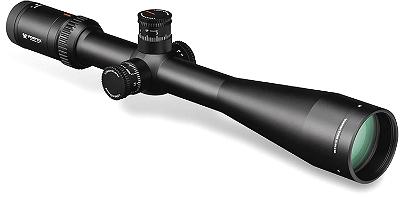 If you’re looking for a very solid scope built on a 30mm tube that is versatile enough to do almost any type of shooting, then this model might be worth checking out.
If you’re looking for a very solid scope built on a 30mm tube that is versatile enough to do almost any type of shooting, then this model might be worth checking out.
The 4-16 magnification range is usually more than enough power, except in extreme long range situations.
This model weighs in at 20.8 ounces so it’s not so heavy that it would weigh you down on a long hunt.
Here are a few places I located with good prices on this model:
Vortex Viper HST 6-24×50 with VMR-1 Reticle (either MOA or MRAD)
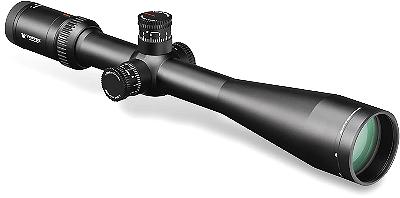 In the 4-16 HST model I mentioned above isn’t enough magnification power for you, then you may want to check out the 6-24×50 version of the Vortex HST series.
In the 4-16 HST model I mentioned above isn’t enough magnification power for you, then you may want to check out the 6-24×50 version of the Vortex HST series.
At my day job, we sell quite a few of this specific model you’re getting a serious amount of features for the money.
Here are a few good prices that I found on the 6-24 model as well:
When it comes to the PST Gen II scope models, I usually break them down into the SFP models and the FFP models. Let’s look at my favorite SFP models in the PST series.
Vortex Viper PST Gen II 3-15×44 Second Focal Plane with the EBR-4 Reticle
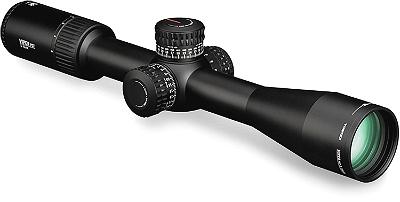 If you want a really nice, second focal plane, mid-powered scope with very good glass, at a reasonable price, then the PST 3-15×44 may be worth checking out.
If you want a really nice, second focal plane, mid-powered scope with very good glass, at a reasonable price, then the PST 3-15×44 may be worth checking out.
The glass is very good for the money, and the EBR-4 reticle is one of my favorite Vortex reticle options.
Here are a few good prices that I found on this scope:
Vortex Viper PST Gen II 5-25×50 Second Focal Plane with the EBR-4 Reticle
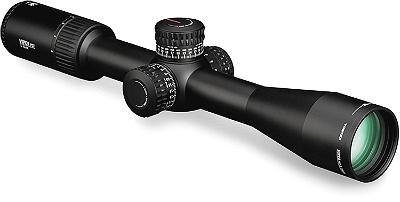 If you’re looking for an SFP scope with a power range that will really let you push the limits of long-range shooting, then the PST 5-25 model may be one to check out.
If you’re looking for an SFP scope with a power range that will really let you push the limits of long-range shooting, then the PST 5-25 model may be one to check out.
Much like the 3-15 model, my only complaint on the 5-25 SFP version is the weight. This bad boy weighs in at just under 33 ounces, so it’s a tank.
However, if you think about what this scope was really designed for, then the weight isn’t really an issue.
Here are some decent prices I was able to find on this model:
Vortex Viper PST Gen II 3-15×44 First Focal Plane with the EBR-7C or EBR-2C Reticle
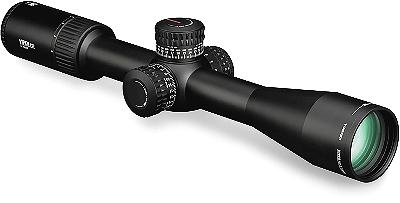 If a second focal plane isn’t your thing, or you want a mid-powered FFP scope that will work for various long range shooting scenarios, then the PST Gen II FFP model in 3-15×44 might be an option for you.
If a second focal plane isn’t your thing, or you want a mid-powered FFP scope that will work for various long range shooting scenarios, then the PST Gen II FFP model in 3-15×44 might be an option for you.
Here are a few good prices I found on this scope model:
Vortex Viper PST Gen II 5-25×50 First Focal Plane with the EBR-7C or EBR-2C Reticle
If FFP is your thing and you want the highest FFP magnification that you can get within the PST Gen II series of scopes, then the 5-25×50 FFP model may be an option for you.
While big and heavy, this is a great FFP scope for the money. I’ve had the chance to shoot under several FFP scopes across a number of different scope brands, with some costing less than this scope and some costing more. I think this is one of the best sub $1000 FFP scopes on the market.
Here are a few places that I found some very good pricing on this specific scope model:
I’ve been working in the firearms and sporting optics industry for over 20 years, with a personal and professional interest in all things related to rifle scopes, Through a combination of work experience, formal training, and personal experiences, I have extensive experience mounting, testing, and evaluating different rifle scope models across most major optical brands.
